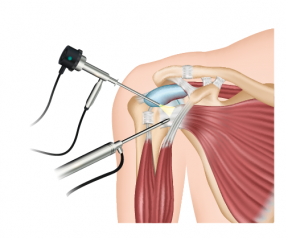DISTAL CLAVICLE EXCISION (Mumford procedure)
A minimally invasive shoulder surgery, Distal Clavicle Excision works to decompress the joint. A shoulder surgeon removes the distal end of the clavicle, nearest to the acromioclavicular (AC) joint, to relieve pain and increase range of motion lost from  shoulder arthritis or shoulder impingement. The need for a Distal Clavicle Excision may arise from an incident of trauma to the shoulder joint.
shoulder arthritis or shoulder impingement. The need for a Distal Clavicle Excision may arise from an incident of trauma to the shoulder joint.
Candidates for Distal Clavicle Excision
Patients who exhibit pain around the acromioclavicular joint may consider Distal Clavicle Excision. Pain around the acromioclavicular joint may arise for a variety of reasons but typically due to shoulder impingement or arthritis. Both more common in older patients, but younger patients can also experience shoulder impingement. Younger patients may also develop issues with the AC joint from athletics with repetitive motion like swimming, tennis, and baseball. A shoulder specialist must perform a physical examination of the patient and order diagnostic testing. A surgeon first attempts conservative treatment like injections, physical therapy, and rest, but if conservative treatments do not work, they result to surgery.
How surgeons perform a Distal Clavicle Excision
An anesthesiologist places the patient under general anesthesia. The patient does not feel anything and remains asleep for the duration of the procedure. The surgeon cleans the shoulder area with antiseptic and makes a few keyhole incisions over the AC joint. One of the incisions hosts the camera while interchangeably using the other portals for the surgical tools. Arthroscopic surgery reduces healing time and decreases the risk of complications. Viewing the joint with the camera, the surgeon excises the distal end of the clavicle responsible for causing impingement. Following the completion of the procedure, the surgeon closes the portals and the patient wears a sling as the joint heals. The surgeon creates a specific physical therapy protocol for the patient and the patient starts the program at the surgeons discretion. The surgeon may also prescribe the patient a dose of antibiotics to ensure a post-operative infection does not occur.
Risks of Distal Clavicle Excision
Any time something penetrates the skin, potential risks or complications may occur. Though less invasive than open surgery, a Distal Clavicle Excision using an arthroscopic approach still comes with potential risks. These risks include:
- Infection
- Joint stiffness
- Scarring of the tissues
- Decreased range of motion
- Instability of the Shoulder
To view a list of all insurances that AOA Orthopedic Specialists accepts, click HERE.
Experiencing shoulder pain? Call 817-375-5200 to schedule an appointment with a shoulder specialist today!



